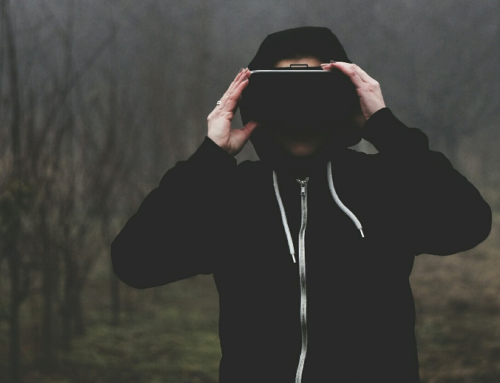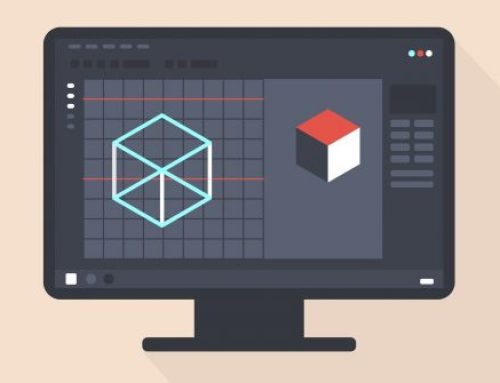Wie Sie Content für VR-Apps entwickeln können.
Virtual Reality (VR) klingt immer noch nach Zukunftsmusik. Das ist aber nicht mehr der Fall, da VR seit einigen Monaten und Jahren schon von Unternehmen und Privatpersonen genutzt wird.

VR kann als eine computersimulierte Umgebung beschrieben werden, die die physische Präsenz in einer realen Welt nachahmt. Um die VR-Welt zu erleben, benötigt der Anwender ein stereoskopisches Head Mounted Display (HMD). Das derzeit fortschrittlichste HMD auf dem Markt ist Oculus Rift. Oculus Rift ist jedoch nicht das einzige Gerät, das Sie in virtuelle Welten eintauchen lässt. Es gibt auch andere erschwinglichere Optionen, wie Google Cardboard, Samsung Gear VR und Zeiss`s VR One. Alle diese Geräte verwenden ihr iPhone oder Android-Smartphone, um virtuelle Videos anzuzeigen.
In dem folgenden Beitrag möchten wir Ihnen aufzeigen, wie Sie die VR-Technologie bei der App-Entwicklung einsetzen können.
Wie kann VR in einer App genutzt werden?
Es gibt mindestens vier Branchen, die bereits VR-Technologie eingesetzt haben.
Immobilien.
Das Immobilienunternehmen Panoptic Group hat letztes Jahr mit Arch Virtual zusammengearbeitet, um VR-Rundgänge in VR zu entwickeln, um den Kunden Immobilienobjekte auf neue Weise zu präsentieren. Laut Panoptic Group hilft VR ihnen, Immobilien viel schneller zu verkaufen, da die Menschen ein Gefühl für das Innere eines Hauses und seines Geländes bekommen können, ohne selbst vor Ort zu sein müssen. Die Panoptic Group verwendet Oculus Rift, das mit einem kompatiblen PC verbunden ist, aber nicht mit mobilen Geräten kompatibel ist. Sie haben ihre Technologie noch nicht in eine mobile App umgewandelt.
Ähnlich wie Arch Virtual ist Start VR ein weiteres Unternehmen, das sowohl 360-Grad-Videos als auch fotorealistische 3D-Welten für seine Kunden produziert. Ihre Projekte reichen von Immobilienrundgänge bis hin zu achtsamen Entertainment-Apps. Start VR hat eine App für den australischen Wohnbauträger EDGE 28 erstellt. Wenn Kunden über ein Smartphone und ein VR-Headset verfügen, können sie sich die Immobilien in 3D ansehen, bevor sie überhaupt einen Fuß in das Büro der Firma setzen.
Reisebranche.
Die Ascape VR-App ist ein großartiges Beispiel von VR für die Reisebranche. Ascape wurde von Yalantis für einen unserer Kunden entwickelt und ermöglicht es den Usern, VR-Rundgänge durch einige der größten Städte der Welt zu unternehmen. Tipp: Sie können sogar die Denkmäler von Pjöngjang besichtigen. Vielleicht hatten Sie nicht vor, Nordkorea zu besuchen, aber Apps wie Ascape können Ihnen helfen, herauszufinden, wohin Sie in Ihren nächsten Urlaub fahren wollen, und können Ihnen helfen, Ihre Besichtigung im Voraus zu planen. All dies kann mit nur einem Smartphone und einem VR-Headset erreicht werden. Im Moment ist die App nur für Android verfügbar, aber sie wird bald auch für iOS veröffentlicht.
Ascape verkauft VR 360 Grad Videos von privaten Content Produzenten.
Automobilindustrie.
Die Automobilindustrie hat VR bereits eingeführt. Unternehmen wie Ford und Audi haben 3D-Erlebnisse geschaffen, mit denen Kunden verschiedene Fahrzeugmodelle ausprobieren und anpassen können, noch bevor sie das Auto im wirklichen Leben sehen. Das ist praktisch, denn es kann zu schnelleren Entscheidungen der Kunden führen und ermöglicht es dem Hersteller, neue Fahrzeugmodelle noch vor der Herstellung des Prototyps zu zeigen. Während Ford und Audi den Oculus Rift für ihre VR-Programme nutzen, hat Volvo tatsächlich eine VR-App veröffentlicht, die es Kunden ermöglicht, den Volvo XC90 bequem vom Sofa aus zu testen. Die Volvo XC90 Probefahrt bietet 360-Grad-Videomaterial mit einer 3D-Animation des Fahrzeuginnenraums.
Bildung.
Eine bekannte Tatsache in Bezug auf Bildung ist, dass sich die Schüler an das Lehrmaterial erinnern und es besser verstehen, wenn sie es erleben, anstatt darüber zu lesen. Deshalb haben Exkursionen an den meisten Schulen einen hohen Stellenwert. VR kann es nun tatsächlich ermöglichen, direkt aus dem Klassenzimmer heraus Exkursionen zu unternehmen.
Vessels VR produziert eine großartige VR-Lernerfahrung für Grundschüler: über den Kreislauf des Körpers mit Oculus Rift. Da man ein 3D-Video im menschlichen Körper nicht wirklich aufnehmen kann, musste Vessels VR auf eine 3D-Animation setzen. Dazu werden sie beide Modelle des Oculus Rift Development Kits verwenden und alles in Unity 3D zusammenstellen. Sie können sich das Projekt auf Kickstarter ansehen.
EON Reality bietet eine Bibliothek mit lehrreichen VR-Erlebnissen in 3D als Apps. Sie bietet VR-App-Entwicklung für Bildungsprojekte an.
Auch wenn VR bereits den Weg zu mobilen Apps gefunden hat, gibt es immer noch keine Killer-App, die Massen von Menschen wirklich in die Welt der Science Fiction tauchen kann. Die VR-Technologie befindet sich noch im Anfangsstadium, entwickelt sich aber rasant weiter. Wenn Sie jetzt mit der Entwicklung Ihrer App beginnen, könnte sie in ein paar Jahren zu etwas werden, das wir uns noch nicht einmal vorstellen können.
Wie Sie Content für eine VR-App entwickeln können.
Es gibt zwei Möglichkeiten, Content für Ihre VR-Anwendung zu erstellen:
- Aufnahme von 360 Grad immersiven Videos.
- Erstellen einer 3D-Animation oder Konstruktion.
Aufnahme eines 360-Grad-Videos.
Von den beiden Möglichkeiten zur Erstellung von VR-Inhalten ist die Aufnahme eines 360-Grad-Videos die kostengünstigere Lösung, da Ihre einzigen Kosten die Kamera und mögliche Bearbeitungskosten sind. 360-Grad-Videos sind nützlich, wenn Sie ein Videomaterial von einem Ereignis aus der realen Welt aufnehmen möchten. Dies kann ein Konzert oder die Verleihung des Nobelpreises sein.
Um 360 Grad Videos aufzunehmen, benötigen Sie zunächst eine 360-Grad-Kugel-Kamera. Die bekanntesten Optionen sind 360Heroes oder RICOH THETA. Weitere Produkte werden voraussichtlich in Kürze verfügbar sein. Bei der Auswahl einer Kamera ist es wichtig, dass Sie sicherstellen, dass Sie die bestmögliche Videoqualität aufnehmen können.
Beim Filmen ist es wichtig, die Kamera in einer ruhigen Position zu halten. Wenn sich die Kamera bewegt, muss sie gleichmäßige Bewegungen beibehalten, da sie sonst für den User zu Motion Sickness führt.
Es gibt verschiedene Möglichkeiten, zu filmen, während die Kamera in einer stabilen Position gehalten wird. Es hängt davon ab, welche Art von Video Sie erreichen wollen. Hier sind einige der häufigsten Möglichkeiten:
- Kamera auf einem Stativ platziert
- Drohnenaufnahmen
- Kamera auf einem Kameramann montiert
Die Ausrüstung, die Sie verwenden, wird in den Aufnahmen sichtbar sein. Wenn Sie möchten, können Sie das Video nachträglich bearbeiten, um es auszublenden.
Da VR ein relativ neues Produkt ist, gibt es nicht so viele Tools zum Bearbeiten von Videos, aber wie bei jedem anderen Gerät ist es nur eine Frage der Zeit, bis weitere VR-Produkte verfügbar sein werden. Wenn Sie etwas zeigen möchten, das Sie in der realen Welt nicht erfassen können, müssen Sie jedoch eine 3D-Animation davon erstellen.
3D Animation für VR.
3D Animationen bieten den Vorteil, dass der Nutzer frei über den Raum schauen kann, in dem er sich befindet. Bei einem 360-Grad-Video sind die User immer am gleichen Ort fixiert und können sich nur durch Schwenken an Ort und Stelle umsehen. Aber mit 3D-Animationen können User tatsächlich auf Buttons klicken, die sie innerhalb der virtuellen Welt bewegen können – im besten Google Street View Stil. Mit 3D Animationen können sich die User auch nach vorne lehnen und die Dinge genauer betrachten, wie sie es im wirklichen Leben erwarten würden.
Eine einfache Lösung für ein 3D-Modell ist der Kauf des Struktursensors. Der Struktursensor ist eine Kamera, die Sie an einem Tablet befestigen können. Es funktioniert wie ein 3D-Scanner, der alles in der realen Welt erfasst und sofort 3D-Modelle davon erstellt. Der Struktursensor funktioniert mit jedem Sensor, am besten aber mit einem iPad.
Eine weitere Möglichkeit ist es, ein 3D-VR-Erlebnis durch Game-Engines wie Unity oder Unreal Engine zu schaffen. Diese werden hauptsächlich für die Spieleentwicklung verwendet, können aber auch für Innenarchitekturen oder jede andere 3D-Konstruktion verwendet werden. Sowohl Unity als auch Unreal Engine haben viele Tutorials auf ihren Seiten, um es Entwicklern leicht zu machen, die Technologie zu nutzen.
Allerdings müssen Sie nicht unbedingt die ganze harte Arbeit selbst machen. Es gibt bereits Unternehmen, die bereit sind, den Content für Sie zu erstellen. Die einzige Frage hier ist: Wir viel kostet es, VR-Content zu erstellen?
Sie können Matterport im Auge behalten, ein Unternehmen, das reale Räume in 3D rekonstruiert, wie beispielsweise das Innere eines Gebäudes. In Kürze wird es einen VR-Showcase geben, der 3D-Konstruktionen durch das neu veröffentlichte Samsung Gear VR zeigt. Matterport liefert 3D-Modelle für Immobilien, Hotels, die Bauindustrie, den Einzelhandel, Versicherungen und öffentliche Einrichtungen. Um eine 3D-Umgebung zu erstellen, müssen Sie lediglich einen Standort mit der Matterport-Kamera scannen und über ihre Cloud an Matterport senden.
Wenn Sie ein 3D-Modell von Matterport erhalten, erwerben Sie eine Matterport-Kamera (4.500 €) und einen Zugang zur Matterport-Cloud (ab 49 € / Monat).
Da sich die VR-Technologie so schnell entwickelt, erwarten wir, dass mehr Unternehmen wie Matterport in naher Zukunft ähnliche Dienstleistungen anbieten werden.
VR-Content muss noch perfektioniert werden. Die Technologie befindet sich noch im Anfangsstadium. Niedrige Auflösungen, Latenzzeiten und der „Screen Door Effekt“, d.h. die Sichtbarkeit der Linien, die Pixel in einem Bildschirm trennen, gehören zu den häufigsten Problemen, die die Illusion zerstören, sich physisch an einem anderen Ort zu befinden. Das wachsende Interesse an dieser Technologie deutet jedoch darauf hin, dass diese Probleme bald gelöst sein werden. VR ist bereits so faszinierend und wir können erwarten, dass bald ein Massenanwendungsfall für VR erfunden wird. Wenn das passiert, wird es unmöglich sein, sich unser Leben ohne VR vorzustellen.
Vielen Dank für Ihren Besuch.


